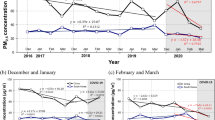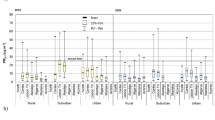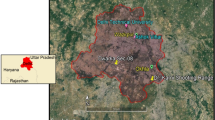Abstract
Many regions in China experience air pollution episodes because of the rapid urbanization and industrialization over the past decades. Here we analyzed the effect of emission controls implemented during the G-20 2016 Hangzhou summit on air quality. Emission controls included a forced closure of highly polluting industries, and limiting traffic and construction emissions in the cities and surroundings. Particles with aerodynamic diameter lower than 2.5 μm (PM2.5) and ozone (O3) were measured. We also simulated air quality using a forecast system consisting of the two-way coupled Weather Research and Forecast and Community Multi-scale Air Quality (WRF-CMAQ) model. Results show PM2.5 and ozone levels in Hangzhou during the G-20 Summit were considerably lower than previous to the G-20 Summit. The predicted concentrations of ozone were reduced by 25.4%, whereas the predicted concentrations of PM2.5 were reduced by 56%.



Similar content being viewed by others

References
Cheng Z, Wang S, Jiang J, Fu Q, Chen C, Xue B, Yu J, Fu X, Hao J (2013) Long-term trend of haze pollution and impact of particulate matter in the Yangtze River Delta, China. Environ Pollut 182(6):101–110. doi:10.1016/j.envpol.2013.06.043
Eder B, Yu SC (2006) A performance evaluation of the 2004 release of Models-3 CMAQ. Atmos Environ 40:4811–4824. doi:10.1016/j.atmosenv.2005.08.045
Guenther AB, Jiang X, Heald CL, Sakulyanontvittaya T, Duhl T, Emmons LK, Wang X (2012) The model of emissions of gases and aerosols from nature version 2.1 (MEGAN2.1): an extended and updated framework for modeling biogenic emissions. Geosci Model Dev 5(6):1–58. doi:10.5194/gmd-5-1471-2012
Hong YW, Chen JS, Deng JJ, Tong L, Xu LL, Niu ZC, Yin LQ, Chen YT, Hong ZY (2016) Pattern of atmospheric mercury speciation during episodes of elevated PM2.5 levels in a coastal city in the Yangtze River Delta, China. Environ Pollut 218:259–268. doi:10.1016/j.envpol.2016.06.073
Huang K, Zhang X, Lin Y (2015) The “APEC Blue” phenomenon: regional emission control effects observed from space. Atmos Res 164:65–75. doi:10.1016/j.atmosres.2015.04.018
Huang ZJ, Ou JM, Zheng JY, Yuan ZB, Yin SS, Chen DH, Tan HB (2016) Process contributions to secondary inorganic aerosols during typical pollution episodes over the Pearl River Delta region, China. Aerosol Air Qual Res 16:2129–2144. doi:10.4209/aaqr.2015.12.0668
Li SW, Li HB, Luo J, Li HM, Qian X, Liu MM, Bi J, Cui XY, Ma LQ (2014) Influence of pollution control on lead inhalation bio-accessibility in PM 2.5: a case study of 2014 Youth Olympic Games in Nanjing. Environ Int 94:69–75. doi:10.1016/j.envint.2016.05.010
Li H, Li L, Cheng H, An J, Yan R, Huang H, Wang Y, Lu Q, Wang Q, Lou S, Wang H, Zhou M, Tao S, Qiao L, Chen M (2015) Ozone source apportionment at urban area during a typical photochemical pollution episode in the summer of 2013 in the Yangtze River Delta. Environ Sci (in Chinese) 36(1):1–10. doi:10.13227/j.hjkx.2015.01.001
Liu HR, Liu C, Xie ZQ, Li Y, Huang X, Wang SS, Xu J, Xie PH (2016) A paradox for air pollution controlling in China revealed by “APEC Blue” and “Parade Blue”. Sci Rep-UK 6:34408. doi:10.1038/srep34408
Lu XC, Yao T, Fung JC, Lin CQ (2016) Estimation of health and economic costs of air pollution over the Pearl River Delta region in China. Sci Total Environ 566–567:134–143. doi:10.1016/j.scitotenv.2016.05.060
Rohde RA, Muller RA (2015) Air pollution in China: mapping of concentrations and sources. PLoS ONE. doi:10.1371/journal.pone.0135749
Skamarock WC, Klemp JB, Dudhia J, Gill DO, Barker DM, Duda MG, Huang X-Y, Wang W, Powers JG (2008) A description of the advanced research WRF version 3, Technical Note TN-475+STR, NCAR
Sun GJ, Yao L, Jiao L, Shi Y, Zhang QY, Tao M, Shan G, He Y (2013) Characterizing PM2.5 pollution of a subtropical metropolitan area in China. Atmos Clim Sci 3:100–110. doi:10.4236/acs.2013.31012
Sun Y, Wang ZF, Wild O, Xu WQ, Chen C, Fu PQ, Du W, Zhou LB, Zhang Q, Han TT, Wang QQ, Pan XL, Zheng HT, Li J, Guo XF, Liu JG, Worsnop DR (2016) “APEC Blue”: secondary aerosol reductions from emission controls in Beijing. Sci Rep 6:20668. doi:10.1038/srep20668
Wang ZB, Fang CL (2016) Spatial-temporal characteristics and determinants of PM2.5 in the Bohai Rim Urban Agglomeration. Chemosphere 148:148–162. doi:10.1016/j.chemosphere.2015.12.118
Wang W, Jariyasopit N, Schrlau J, Jia Y, Tao S, Yu TW, Dashwood RH, Zhang W, Wang X, Simonich SL (2011) Concentration and photochemistry of PAHs, NPAHs, and OPAHs and toxicity of PM2.5 during the Beijing Olympic Games. Environ Sci Technol 45:6887–6895. doi:10.1021/es201443z
Wen W, Cheng SY, Chen XF, Wang G, Li S, Wang XQ, Liu XY (2016) Impact of emission control on PM2. 5 and the chemical composition change in Beijing-Tianjin-Hebei during the APEC summit 2014. Environ Sci Pollut R 23:4509–4521. doi:10.1007/s11356-015-5379-5
Wong DC, Pleim J, Mathur R, Binkowski F, Otte T, Gilliam R, Pouliot G, Xiu A, Young JO, Kang D (2012) WRF-CMAQ two-way coupled system with aerosol feedback: software development and preliminary results. Geosci Model Dev 5:299–312. doi:10.5194/gmd-5-299-2012
Xing J, Zhang Y, Wang SX, Liu XH, Cheng SH, Zhang Q, Chen YS, Streets DG, Jang C, Hao JM, Wang WX (2011) Modeling study on the air quality impacts from emission reductions and atypical meteorological conditions during the 2008 Beijing Olympics. Atmos Environ 45:1786–1798. doi:10.1016/j.atmosenv.2011.01.025
Yan RC, Yu SC, Zhang QY, Li PF, Wang S, Chen BX, Liu WP (2015) A heavy haze episode in Beijing in February of 2014: characteristics, origins and implications. Atmos Pollut Res 6:867–876. doi:10.5094/apr.2015.096
Yarwood G, Rao S, Yocke M, Whitten GZ (2005) Final report-updates to the carbon bond chemical mechanism: CB05,Rep. RT-04-00675, 246 pp., Yocke and Co., Novato, California. Available at: http://www.camx.com/publ/pdfs/CB05_Final_Report_120805.pdf
Yu SC, Eder B, Dennis R, Chu SH (2006) New unbiased symmetric metrics for evaluation of air quality models. Atmos Sci Lett 7:26–34. doi:10.1002/asl.125
Yu SC, Zhang QY, Yan RC, Wang S, Li PF, Chen BX, Liu WP, Zhang XY (2014a) Origin of air pollution during a weekly heavy haze episode in Hangzhou, China. Environ Chem Lett 12:543–550. doi:10.1007/s10311-014-0483-1
Yu SC, Mathur R, Pleim J, Wong D, Gilliam R, Alapaty K, Zhao C, Liu X (2014b) Aerosol indirect effect on the grid-scale clouds in the two-way coupled WRF-CMAQ: model description, development, evaluation and regional analysis. Atmos Chem Phys 14(20):11247–11285. doi:10.5194/acp-14-11247-2014
Yu SC, Li PF, Yan RC, Wang S, Liu WP (2015) Air quality real-time forecast of PM2.5 in Hangzhou metropolitan city with the WRF-CMAQ and WRF/Chem systems: model development and evaluation. In: 14th Annual CMAS conference, October 3–7, Chapel Hill, NC, USA
Zhang Y, Liu P, Pun B, Seigneur C (2006) A comprehensive performance evaluation of MM5-CMAQ for summer 1999 Southern Oxidants Study Episode, Part I. Evaluation protocols, databases, and meteorological predictions. Atmos Environ 40:4825–4838. doi:10.1016/j.atmosenv.2005.12.043
Zhao PS, Dong F, He D, Zhao XJ (2013) Characteristics of concentrations and chemical compositions for PM2.5 in the region of Beijing, Tianjin, and Hebei, China. Atmos Chem Phys 13:4631–4644. doi:10.5194/acp-13-4631-2013
Acknowledgements
This work was partially supported by the Department of Science and Technology of China (No. 2016YFC0202702, No. 2014BAC22B06) and National Natural Science Foundation of China (No. 21577126). This work was also supported by the Joint NSFC–ISF Research Program (No. 41561144004), jointly funded by the National Natural Science Foundation of China and the Israel Science Foundation. Part of this work was also supported by the “Zhejiang 1000 Talent Plan” and Research Center for Air Pollution and Health in Zhejiang University. YZ acknowledges the support from DOE (DE-SC0006695) and NSF (AGS-1049200) at NC State, USA. The views expressed in this presentation are those of the author(s) and do not necessarily represent those of the US EPA.
Author information
Authors and Affiliations
Corresponding author
Rights and permissions
About this article
Cite this article
Li, P., Wang, L., Guo, P. et al. High reduction of ozone and particulate matter during the 2016 G-20 summit in Hangzhou by forced emission controls of industry and traffic. Environ Chem Lett 15, 709–715 (2017). https://doi.org/10.1007/s10311-017-0642-2
Received:
Accepted:
Published:
Issue Date:
DOI: https://doi.org/10.1007/s10311-017-0642-2



